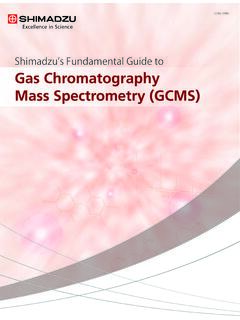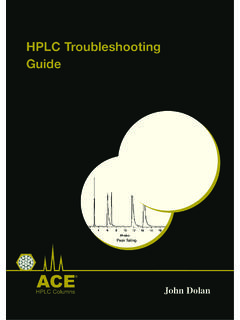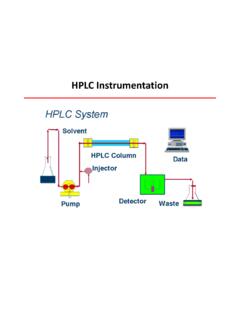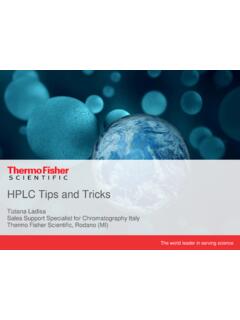Transcription of Tips for practical HPLC analysis
1 tips for practical hplc analysis Separation Know-how Shimadzu LC World Talk Special Issue Volume 2C190-E094 2 3 ContentsPage1. Preparation of Mobile Phases42. Differences between Acetonitrile and Methanol in Reversed Phase Chromatography63. Preparing Mobile phases - Solvent Mixing Ratio -84. Preparing Buffer Solutions95. pKa and Dissociation Equilibrium106. Water Grade117. Gradient Baseline for Acetonitrile Containing TFA128. Ion-Pair Chromatography - Choosing between Alkyl Sulfonate and Perchloric Acid -149. Measuring Accurately with Electronic Balances1610.
2 Causes of Quantitative Errors Originating in Sample Preparation1811. Peaks Caused by Dissolved Air in Sample Solvents2012. Influence of Sample Solvent on Peak Shape2213. Check Methods for Abnormal Increases in Solvent Delivery Pressure2314. Internal Standard Method2615. Formulas for Number of Theoretical Plates27 This is an compilation of articles related to tips for preparation of mobilephase and samples from introductory, laboratory and technical sections of past issues of the "LCtalk", Shimadzu's newsletter for hplc users, Japanese version. 4 Preparation of Mobile PhasesAqueous solvents, organic solvents, and mixtures of these types of solvents are usually used as the mobile phase in high performance liquid chromatography ( hplc ).
3 Buffer solutions are often used as aqueous solutions. Specific preparation methods for some of the representative buffer solutions used in hplc are given on page 9. In general, however, there are many cases where the definition of buffer solutions is vague. There are also cases where, because of differences between the instructions given in documentation and the actual preparation methods used, disparities in mobile phases occur that will affect the chromatograms and the analysis results. There are many aspects of mobile phase preparation that can be thought of as blind spots. This applies not just to buffer solutions but also, for example, to solvent mixing methods. Here, using phosphate buffer as an example, we will look at the effect that the mobile phase preparation method can have on analysis ) Preparation of Buffer SolutionsIn general, how is something described as "20 mM phosphate buffer solution (pH )" actually prepared?
4 We will look at several possible cases. First, let us assume that we are talking about a buffer solution that uses phosphoric acid, but that the counterions are unclear. If we assume that they are sodium ions, the next problem is that we do not know whether the "20 mM" refers to the concentration of the phosphoric acid or sodium phosphate. If we think of this solution as "20 mM phosphoric acid (sodium) buffer solution", we can consider "20 mM" to be the concentration of phosphoric acid. If, however, we consider "20 mM" to be the concentration of sodium, we can think of this solution as a "buffer solution created by the pH adjustment of an aqueous solution of 20 mM sodium dihydrogen phosphate".
5 (The pH value of an aqueous solution of 20 mM sodium phosphate is roughly , so in order to attain a pH value of , pH adjustment with some acid is required.) Depending on the acid used for pH adjustment, the ion-pair effect may occur, and there may be some influence on the analysis results. We can see then that there are several possible interpretations for the term "buffer solution".Fig. 1 shows the effect on the analysis results of interpreting the above example three different ways. The top line shows the result obtained by interpreting "20 mM" as the concentration of phosphoric acid and using a solution prepared as "20 mM 1. Acetaminophen2. Dihydrocodeine3. CaffeinePeaks Chemical Structures of ConstituentsFig.
6 1 Influence of pH Adjustment Method Used for Buffer SolutionsAnalysis ConditionsColumn: Shim-pack VP-ODS (150 mm mm )Mobile Phase: Buffer solution (pH ) / Acetonitrile = 9/1 (v/v) Top (A): 20 mM phosphoric acid (sodium) Buffer solution (pH ) Middle (B): 20 mM sodium dihydrogen phosphate Buffer solution (pH ) (Phosphoric acid added for pH adjustment.) Bottom (C): 20 mM sodium dihydrogen phosphate Buffer solution (pH ) (Perchloric acid added for pH adjustment.)Flow Rate: 1 mL/minTemperature: 40 CDetection: 210 nmPeaks 1: acetaminophen 2: dihydrocodeine 3: caffeine 5phosphoric acid (sodium) buffer solution (pH )" as the mobile phase.
7 The middle and bottom lines show the results obtained by interpreting "20 mM" as the concentration of sodium dihydrogen phosphate, and adjusting the pH value to by respectively adding phosphoric acid and perchloric acid. As illustrated by dihydrocodeine in this example, there are cases where the retention time and consequently the robustness of the analysis technique are significantly affected. Indicating the preparation method for buffer solutions so that the solution can be accurately identified helps to prevent problems resulting from differences in ) Mixing Organic Solvents and Aqueous SolventsSolutions obtained by mixing organic solvents and aqueous solvents are sometimes used as mobile phases .
8 The way in which mixing is performed can have a significant effect on the analysis results. As an example, let us consider a mixture that is 90% 20 mM phosphoric acid (sodium) buffer solution (pH ) and 10% acetonitrile. If we consider this description to indicate that the mixing ratio is 9:1, this implies that the ratio of the volume of 20 mM phosphoric acid (sodium) buffer solution (pH ) to that of acetonitrile is 9:1; in other words, amounts corresponding to this ratio are measured out and mixed. On the other hand, if we consider this description to simply mean "10% acetonitrile", this implies that 20 mM phosphoric acid (sodium) buffer solution (pH ) is used, and is diluted with acetonitrile.
9 Applying the latter interpretation changes the relative volumes and consequently the amount of 20 mM phosphoric acid (sodium) buffer solution is larger. There is a tendency to think that there is no significant difference between these two interpretations. Fig. 2, however, shows how the mixing method used can have a significant effect on the analysis results (particularly retention times).In general, regarding the preparation of mobile phases for hplc , it seems that the notation "A:B = 3:2 (V:V)", indicating that an amount of solution A corresponding to a relative volume of 3 and an amount of solution B corresponding to a relative volume of 2 are separately measured out and mixed together, is commonly used.
10 (In practice, the total volume of the mixture will be less than a relative volume of 5.)The problems mentioned above occur not only in the preparation of mobile phases , but also in the preparation of sample solutions and other solutions. Also, different practices and conventions are used in different fields ( , pharmaceuticals, chemical industry), further adding to the potential causes of confusion. Official documents, such as the Japanese Pharmacopoeia, Standard Methods of analysis for Hygienic Chemists, and Japanese Industrial Standards (JIS) give general principles and definitions related to the preparation of solutions. It is advisable to refer to these documents and to strive on a daily basis to use notation that avoids 2 Influence of Mixing Method Used for Mobile PhaseAnalysis ConditionsColumn: Shim-pack VP-ODS (150 mm mm )Mobile Phase: Top (A): 20 mM (phosphoric-acid) sodium buffer solution (pH ) / Acetonitrile = 9/1 (v/v) Bottom (B): Acetonitrile diluted by a factor of 10 with 20 mM (phosphoric-acid) sodium buffer solution (pH )Flow Rate: 1 mL/minTemperature: 40 CDetection: 210 nmPeaks 1: acetaminophen 2: dihydrocodeine 3.








